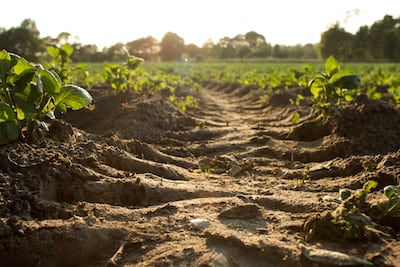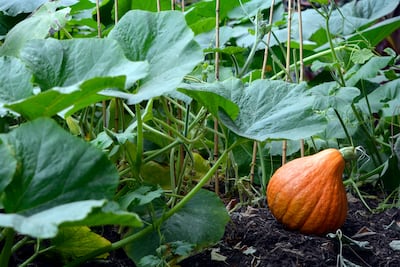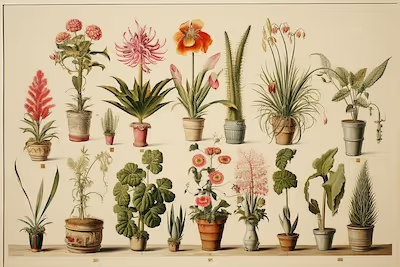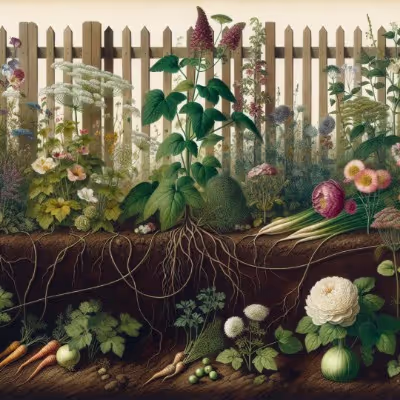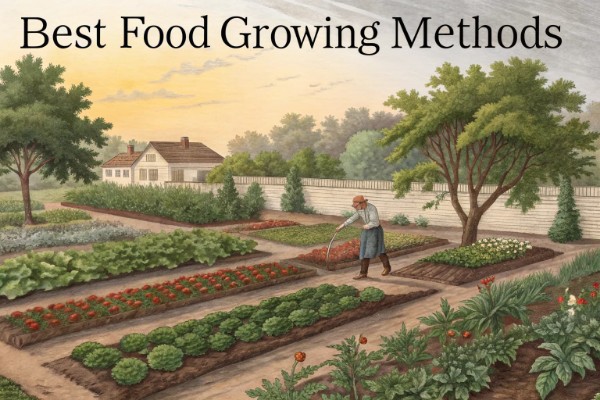When Are Vegetables in Season? Know What to Plant and When
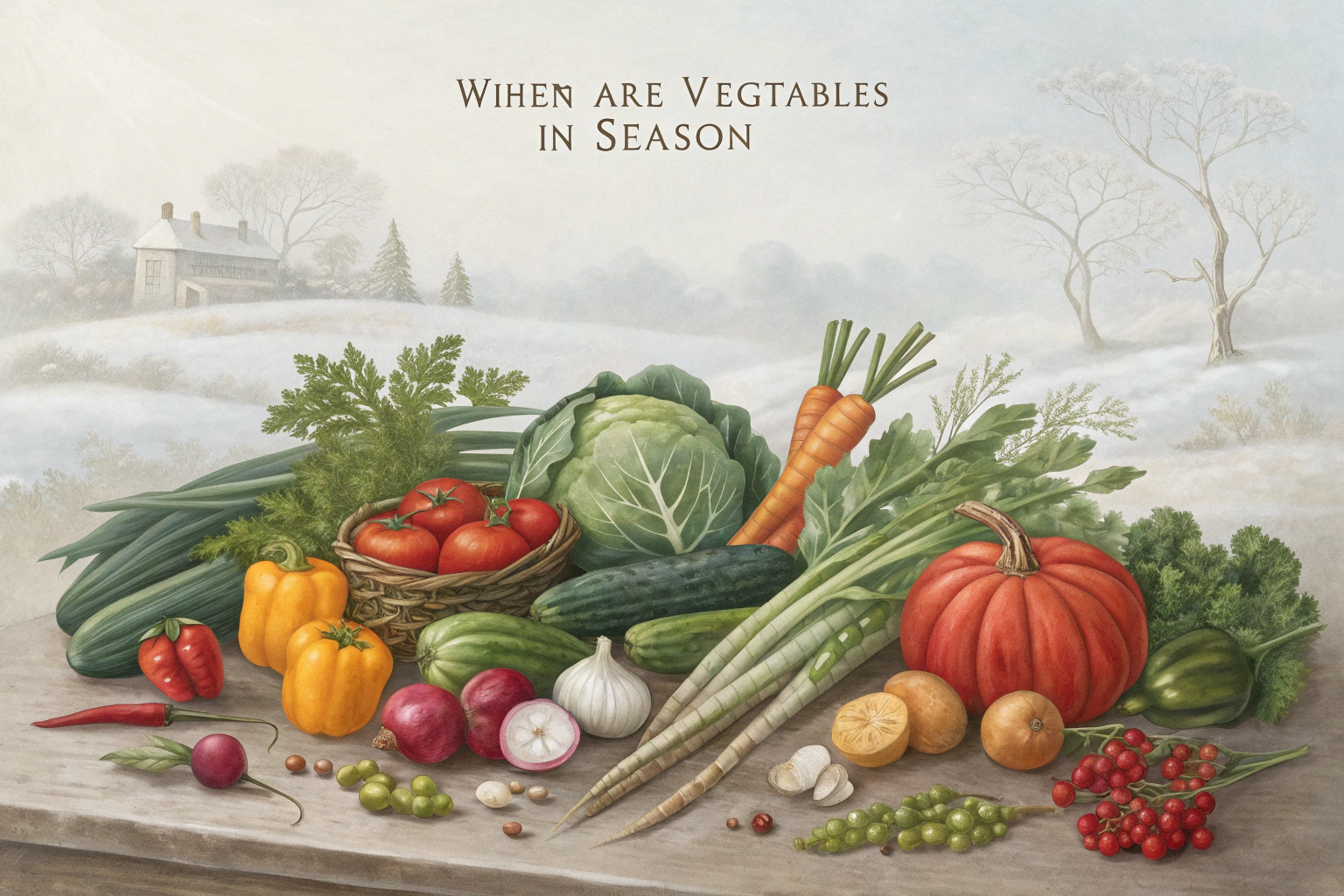
When are vegetables in season
When are vegetables in season? This single question shapes flavor, nutrition, and value in your kitchen. Knowing when vegetables are in season lets you buy at peak freshness, support local growers, and serve up bold, distinctive taste on every plate. Stick around and I’ll walk you through what’s ripe, ready, and worth tossing into your cart each month of the year.
Cheatsheet: Peak Vegetable Harvest Timing
🌱 Spring Crops
- March-May: Asparagus, lettuce, spinach, peas, radish
- Best Flavor: Cooler temps (50–70°F / 10–21°C)
☀️ Summer Harvests
- June-August: Tomatoes, zucchini, peppers, corn, beans, cucumbers
- Peak Nutrition: Sun-grown veggies hold more vitamin C, lycopene
🍂 Autumn Bounty
- Sept-Nov: Broccoli, brussels sprouts, kale, carrots, sweet potatoes
- Frost Improves: Carrots, kale, brussels sprouts sweeten after light frost (30–40°F / -1–4°C)
❄️ Winter Picks
- Dec–Feb: Cabbage, leeks, parsnips, stored squash, root vegetables
- Cold Storage: Many roots keep 2–6 months at 32–40°F (0–4°C)
📅 Quick Reference by Vegetable
- Leafy greens: Spring, Fall
- Nightshades: Summer
- Brassicas: Fall, Winter
- Roots: Fall, Winter
- Legumes: Spring, Summer
🔪 Tools and Products You'll Need
- Harvest knife or scissors
- Produce basket
- Garden calendar or app
- Cool storage (basement or fridge)
🏆 Steps to Maximize Seasonal Flavor
- Check region’s last/first frost dates
- Mark peak harvest windows above
- Plan meals around what’s ripe
- Store or preserve extra crops
- Adjust next year’s sowing for longer harvest
🥗 Self-Sufficiency & Health Boost
- Seasonal veggies can offer 40% more nutrients
- Locally grown reduces carbon footprint
- Supports immune health via variety
When Are Vegetables in Season? Timing Your Harvest for Peak Flavor
Few pleasures rival biting into a sun-warmed tomato picked in its prime. Timing the harvest right transforms good produce into unforgettable meals.
Understanding Vegetable Seasonality
Seasonality refers to the time of year vegetables reach their peak flavor and nutritional value, influenced by temperature, daylight, and rainfall.
The USDA spells it out plainly: "Seasonal produce is fresher, tastier, and more nutritious than food consumed out of season." It's no old wives’ tale — flavor and nutrition both peak when you respect the calendar.
Why Season Matters
Out-of-season produce travels far, sometimes thousands of miles, losing quality and killing taste. In-season veggies celebrate local terroir and cut food miles dramatically.
Fresh vegetables can lose up to 50% of their vitamin C after seven days in storage. (University of California, Davis)
The Three Growing Seasons
- Cool Season: Early spring and fall, favoring lettuce, spinach, peas, broccoli. Optimal temperature: 55–75°F (13–24°C).
- Warm Season: Late spring through summer, with tomatoes, peppers, squash. These love heat, thriving at 70–95°F (21–35°C).
- Very Hot Season: Peak summer in southern regions, okra and sweet potatoes revel in the heat.
Listicle: Best Time to Grow and Harvest Common Vegetables
- Spinach, Kale, Lettuce: Early spring and fall. Tolerate frost but bolt in heat.
- Carrots, Beets, Radishes: Sow as soon as soil is workable. Sweeten after a light frost.
- Peas: Plant peas once soil hits 45°F (7°C). Harvest before heat waves.
- Tomatoes, Peppers, Eggplants: Transplant after last frost. Fruit ripens midsummer to early fall.
- Sweet Corn: Mid-to-late spring sowings, harvest summer through early fall.
- Winter Squash, Pumpkins: Plant late spring, harvest at summer’s end before first hard frost.
Regional Nuance
Zone maps matter. USDA Hardiness Zones and RHS Hardiness Ratings give clues, but microclimates and local rainfall shift the rules. I once harvested arugula in December in Oregon. In Tucson, the same seed bolts by May.
Extending the Season
Row covers, cold frames, high tunnels — these let you hack the calendar. I’ve nursed spinach under double covers through February snow. Commercial growers use these tricks too, offering "season extension" produce at farmers’ markets.
Comparing Supermarket and Homegrown Seasonality
- Supermarket: Often ships in from Chile, Mexico, or California. Variety bred for shelf-stability, not taste.
- Homegrown: Picked at ripeness, showcasing full sugar and acid profiles. Zero food miles. Your soil and care define the flavor.
Best Tools for Finding Local Vegetable Seasons
- State cooperative extension websites publish local planting and harvest charts.
- Online apps like Taim.io tailor planting instructions by postcode, garden size, and your favorite vegetables.
- Farmers’ market guides — ask the growers about their best weeks for each crop.
“Eating in season means enjoying vegetables at their peak of flavor — and nutrition.” — Marion Nestle, public health nutritionist
Why Gardeners Should Care
Seasonal eating lets you savor each vegetable as it was meant to taste. Every year I mark the weeks for my favorite tomatoes and beans. The fleeting nature makes them all the sweeter.
Tune into your garden’s cues. Trust the soil, the weather, and your own notes. If you want to save time trial-and-error with planting and harvest dates, personalized instructions from Taim.io make a difference.

Want smarter plant choices? 🪴
Frequently Asked Questions About Vegetable Harvest Times
Why do vegetable harvest periods differ across regions?
Geography has a direct impact on harvest times. Local climate, altitude, soil temperature, and rainfall cause vegetables to ripen earlier in warmer areas compared with cooler zones. A southern gardener in the USA may start picking tomatoes in June, while northern growers might wait until July or August. Average last and first frost dates also influence the growing window.
How do I determine the peak freshness for my vegetables?
Check for seasonal cues such as abundant supply at local farmers markets or roadside stands. Vegetables like sweet corn and tomatoes reach their best flavor when grown in full sun and harvested at their natural ripeness. Use a calendar and note average daylight hours and temperatures (60 - 85°F / 16 - 29°C suits most summer crops). Consult local cooperative extensions for tailored timetables.
Are planting dates and harvest dates always the same each year?
Fluctuating weather patterns mean specific dates can shift by several weeks. Early or late springs, periods of drought, or unexpected frosts impact both when you plant and when vegetables reach maturity. Monitor weekly forecasts and soil temperatures using a thermometer (50°F / 10°C for cool-season crops; 60°F / 16°C for warm-season crops) to adjust your calendar.
Should I stagger plantings to lengthen my harvest window?
Many gardeners practice succession planting, sowing seeds every 1-3 weeks for crops like lettuce, carrots, and bush beans. This technique stretches out the period of peak picking and keeps meals filled with truly fresh produce. Match your planting to each crop’s maturity times and your local conditions.
Can greenhouses or cold frames affect when my vegetables ripen?
Season extenders such as greenhouses, cold frames, or cloches allow some vegetables to mature earlier in spring and linger longer into autumn. They retain heat and raise air and soil temperatures, letting you plant seeds ahead of the typical outdoor schedule or continue harvesting cold-hardy types like spinach and kale after the first frost.
When are vegetables in season? The answer lives in your dirt, your weather, and the length of light each day. Spring brings leafy greens and peas. Summer is a riot of tomatoes, cucumbers, and beans. Fall has roots and brassicas. Winter, if you’re clever or live in the right zone, can still surprise you. If you want to track specific crops, check this garden vegetables list or get inspired by summer vegetables that thrive in heat. Your planting zone shapes what you can grow and when. Each season is a new chapter, shaped by nature’s schedule, not the supermarket’s. Want more? Browse gardening tips and grow with the seasons, not against them.
The Science Shaping Seasonal Vegetables
Vegetable crops run on biological schedules, set by light, soil warmth, and rainfall. Knowing these patterns preserves flavor, nutrition, and resilience in your harvest—store-bought cannot match these seasonal peaks. Research shows spinach harvested in its spring flush carries up to 50% more vitamin C than late-harvested leaves.
Photoperiods and Crop Triggers
- Day length signals germination and flowering. Lettuce bolts when daylight exceeds 14 hours; onions bulb only after sensing 12-15 hour days.
- Cool-season crops (peas, broccoli, radish): thrive when soil stays below 70°F (21°C).
- Warm-season crops (tomato, corn, beans): require nights above 50°F (10°C) and soil above 60°F (16°C).
Soil Microbes and Nutrient Density
- Spring and fall moisture wakes dormant Rhizobium and mycorrhizae, boosting pea, bean, and brassica nutrition.
- Peak microbe activity rises when soil ranges 68–77°F (20–25°C), maximizing nutrient draw for fruiting and leafy greens.
Water and Flavor Chemistry
- Root crops like carrots and beets become sweeter after brief frost triggers sugar storage; late summer sun intensifies tomato lycopene.
- Crisp, rain-fed greens harvested at sunrise retain 30% more polyphenols than heat-stressed midday picks.
Extend Season with Microclimates
- South-facing walls deliver 5°F (3°C) extra warmth—enough to ripen late peppers or tomatoes.
- Row covers and cloches hold warmth, add 2–8 weeks to spinach, arugula, and radish harvests.
Nutrition: Eating with the Seasons
- Spring broccoli, snap peas, and salad greens carry peak antioxidants and vitamins—up to double compared to out-of-season imports.
- Summer squash and tomatoes, picked ripe, supply 40% more lycopene and beta-carotene than pre-ripened produce.
Find out which plants will thrive in your garden!
Answer a few fun questions and get custom plant recommendations perfect for your space. Let’s grow something amazing together!

start your season
